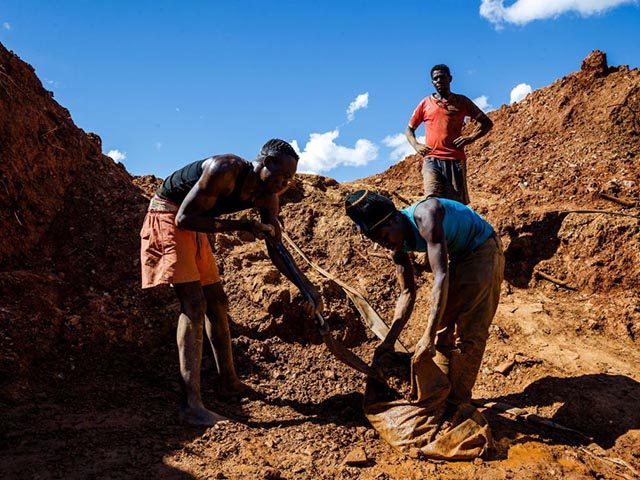A Chinese mining company operating in east Zimbabwe halted a search mission for ten illegal gold miners believed to have been accidentally “buried alive” on November 15 as it is too expensive to find them, New Zimbabwe reported on Monday.
The miners were reportedly trapped in a collapsed mine shaft at the Premier Estate mining site in Mutasa District, Manicaland Province, on November 15, but the rescue mission to retrieve them did not start until November 26.
The miners are described as “illegal miners” by New Zimbabwe and Africanews and as “illegal gold miners” by China’s state-run news agency Xinhua. The designation indicates that the people were mining without an official permit or permission from the Chinese firm operating the site, Zhong Jin. Like Xinhua, Africanews implied on Monday that the miners were participants in the country’s illegal gold mining trade, which it said, “is rampant in Zimbabwe and results in deaths of several people every year.” None of the news outlets explicitly stated if the miners were African or Chinese.
“We have halted mission after working for four continuous days. We will cooperate and we are willing to assist the community but only after police completes investigations and identify the proper location [sic],” the company’s general manager, Yancey Feng, told reporters on Monday, according to New Zimbabwe. “It’s expensive to continue running the equipment without identifying the proper location,” he added.
“Two bodies of illegal gold miners were retrieved from a collapsed mineshaft on Sunday [November 15] in the eastern Mutasa District of Zimbabwe, while 10 others are feared dead following the mishap which occurred at the weekend,” Xinhua reported on November 17.
“Rescue efforts were already underway at Premier Estate in Mutasa District, Manicaland Province, where the incident happened,” the news agency reported at the time. “The acting District Development Coordinator for Mutasa is currently on the ground to assess the situation and what we understand is that only two people were retrieved Sunday.”
“We are yet to ascertain the number of people trapped inside,” Manicaland Provincial Development Coordinator and Civil Protection Unit head Edgars Seenza told reporters on November 17.
“Permanent Secretary in the Ministry of Information and Publicity Nick Mangwana said the 10 illegal miners were feared to have been buried alive at the Premier Mining area along Mutare River, which is owned by Zimgold Fields, a privately owned company in Mutasa District,” Xinhua reported. Zimgold is a Zimbabwean cooking oil producer.
Xinhua’s November 17 report supports New Zimbabwe‘s report on Monday that local police say “only two bodies have been recovered from the rescue mission [so far].”
According to the newspaper, Zhong Jin “says it has halted search operations until police produce concrete evidence there were indeed missing persons from the local community [trapped inside the mine shaft].” The newspaper’s designation of the miners as “missing” seems to be a reference to their being not yet accounted for, inside the collapsed shaft.
Feng said Zhong Jin was contracted by Zimgold to conduct a land reclamation exercise in the area but had not yet begun the process. Land reclamation means reconverting disturbed land to its former use. In mining, this typically involves filling previously dug shafts with soil or rock.
“We have not started mining but waiting for approval to mine in partnership with Zimgold. So far, we are just filling the pits [sic],” he explained.
According to New Zimbabwe, the manager “disputed claims the firm has embarked on a land reclamation exercise without notifying the local community.”
“We had the blessings of the police,” he insisted on Monday.
Local police leader Phillip Nyateka “confirmed that a notice was issued before the reclamation exercise,” according to the report. Nyateka confirmed the notice’s receipt while “speaking before a Parliamentary Portfolio Committee on Mines and Mining Development that toured the disaster area last week.”
“Our duty was to provide security and not lead the investor in doing his operations. We were not involved in anything other than providing what we are sanctioned to do by the Constitution,” Nyateka told the committee.
“Reports we received of missing persons were three. The first one turned out to be positive. There was a man who was living with his in-laws and lied that he was going to Mutare river but going to Premier Estates [the Chinese mine site]. It was later discovered that he was among those who were buried alive,” the police superintendent stated.
Nyateka said he sought assistance from Zhong Jin in searching for the miners believed to be trapped in the mine. He also looked to a local Civil Protection Unit for help. Nyateka revealed that “[some of] the bodies of the victims were retrieved and positively identified.”
China’s presence in Zimbabwe’s mining industry is the result of its infrastructure-building Belt and Road Initiative (BRI), which Beijing uses to establish influence in developing countries. The BRI requires Chinese companies to operate within African nations to build and revamp various infrastructure projects, such as roads and ports. Ethnic Chinese workers are shipped to African countries to manage these on the ground firms, often leading to cross-cultural tensions between the typically ethnic Chinese managing class and native African laborers.
This is especially salient in Zimbabwe, where Chinese-run mines often cause problems for the local community in which they operate. A Chinese manager of a gold mine in central Zimbabwe shot and injured two Zimbabwean ex-employees of the mine site in June. The incident was allegedly sparked by a wage dispute in which the ex-employees demanded salaries after they were fired by the manager.

COMMENTS
Please let us know if you're having issues with commenting.